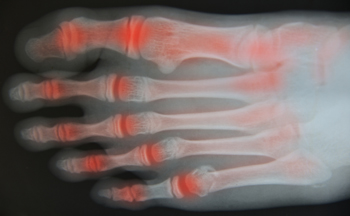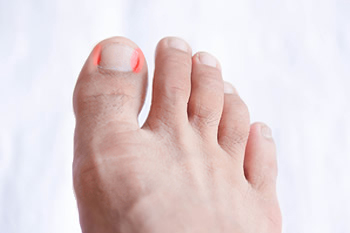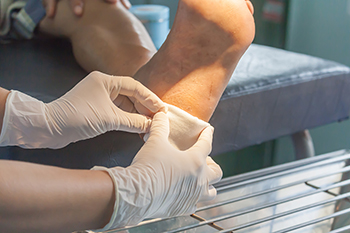May 2022
Treating Painful Symptoms of Rheumatoid Arthritis

Rheumatoid arthritis can be a debilitating disease where a joint's lining (synovium) is attacked by the body’s immune system. This causes the synovium to become inflamed, which damages the surrounding tissues and ligaments. In time, this may dislocate toe joints and cause deformities such as bunions and hammertoes. Along with toe joints, rheumatoid arthritis can also occur in the ankle joint, the tarsometatarsal joints in the midfoot, and the hindfoot (heel area). While rheumatoid arthritis has no cure, a podiatrist can help treat its symptoms which, if left untreated, may inhibit a person’s ability to lead a normal life. Your podiatrist may prescribe special shoes, braces, and/or create custom orthotics to help restore functionality to the feet and ankles and relieve pain. Icing, gentle exercises, and physical therapy may also help relieve symptoms, as can corticosteroid injections. Make an appointment with a podiatrist today to begin treatment for your painful rheumatoid arthritis symptoms.
Because RA affects more than just your joints, including the joints in your feet and ankles, it is important to seek early diagnosis from your podiatrist if you feel like the pain in your feet might be caused by RA. For more information, contact Dr. Lee R. Stein of Lake Shore Foot & Ankle, PC. Our doctor will assist you with all of your podiatric concerns.
What Is Rheumatoid Arthritis?
Rheumatoid Arthritis (RA) is an autoimmune disorder in which the body’s own immune system attacks the membranes surrounding the joints. Inflammation of the lining and eventually the destruction of the joint’s cartilage and bone occur, causing severe pain and immobility.
Rheumatoid Arthritis of the Feet
Although RA usually attacks multiple bones and joints throughout the entire body, almost 90 percent of cases result in pain in the foot or ankle area.
Symptoms
- Swelling and pain in the feet
- Stiffness in the feet
- Pain on the ball or sole of feet
- Joint shift and deformation
Diagnosis
Quick diagnosis of RA in the feet is important so that the podiatrist can treat the area effectively. Your doctor will ask you about your medical history, occupation, and lifestyle to determine the origin of the condition. Rheumatoid Factor tests help to determine if someone is affected by the disease.
If you have any questions please feel free to contact one of our offices located in Chicago, Highland Park, and Uptown, IL . We offer the newest diagnostic and treatment technologies for all your foot and ankle needs.
Dealing with Ingrown Toenails

Ingrown toenails occur when the toenail grows into the surrounding skin, usually at the side of the nail. This is an irritating and painful annoyance that can also cause the skin to become red and swollen. What can make an ingrown toenail worse is if the skin breaks and bacteria enters the skin, causing an infection, drainage and an unpleasant odor. This is potentially dangerous for individuals with diabetes, poor circulation, or nerve damage. Ingrown toenails usually develop from improper toenail grooming. Toenails should always be trimmed straight across (never curved), and they should not be cut too short. Keeping nails flush with the tip of the toe is suggested, as anything shorter may encourage the nail to grow into the skin, not over it. Other risk factors for an ingrown toenail include experiencing trauma/injury to the toenail, wearing shoes that are too short or tight, inheriting a predisposition to ingrown toenails, or having a fungal toenail infection. If you have an ingrown toenail, contact a podiatrist who can relieve your symptoms, address any possible infection, and help avoid future ingrown toenails.
Ingrown toenails may initially present themselves as a minor discomfort, but they may progress into an infection in the skin without proper treatment. For more information about ingrown toenails, contact Dr. Lee R. Stein of Lake Shore Foot & Ankle, PC. Our doctor can provide the care you need to keep you pain-free and on your feet.
Ingrown Toenails
Ingrown toenails are caused when the corner or side of a toenail grows into the soft flesh surrounding it. They often result in redness, swelling, pain, and in some cases, infection. This condition typically affects the big toe and may recur if it is not treated properly.
Causes
- Improper toenail trimming
- Genetics
- Improper shoe fitting
- Injury from pedicures or nail picking
- Abnormal gait
- Poor hygiene
You are more likely to develop an ingrown toenail if you are obese, have diabetes, arthritis, or have any fungal infection in your nails. Additionally, people who have foot or toe deformities are at a higher risk of developing an ingrown toenail.
Symptoms
Some symptoms of ingrown toenails are redness, swelling, and pain. In rare cases, there may be a yellowish drainage coming from the nail.
Treatment
Ignoring an ingrown toenail can have serious complications. Infections of the nail border can progress to a deeper soft-tissue infection, which can then turn into a bone infection. You should always speak with your podiatrist if you suspect you have an ingrown toenail, especially if you have diabetes or poor circulation.
If you have any questions, please feel free to contact one of our offices located in Chicago, Highland Park, and Uptown, IL . We offer the newest diagnostic and treatment technologies for all your foot care needs.
Possible Complications of Ankle Fractures

The bones in the ankle that are prone to breaking are the tibia, fibula, and talus. The tibia and fibula can be felt on the outside of the ankle, while the talus is deep within the ankle. If significant pressure is applied to these bones from occurrences such as a car accident, falling or tripping, the impact of heavy weight, overuse, or a misstep, can all result in a break. A broken ankle can lead to loss of blood supply, damage to neighboring tissues, improper healing, and sharp pieces of bone from the break compressing or severing nearby nerves or blood vessels. It is important to see a podiatrist if you have broken your ankle in order to obtain proper treatment and to prevent more serious complications from arising.
Broken ankles need immediate treatment. If you are seeking treatment, contact Dr. Lee R. Stein from Lake Shore Foot & Ankle, PC. Our doctor can provide the care you need to keep you pain-free and on your feet.
Broken Ankles
A broken ankle is experienced when a person fractures their tibia or fibula in the lower leg and ankle area. Both of these bones are attached at the bottom of the leg and combine to form what we know to be our ankle.
When a physician is referring to a break of the ankle, he or she is usually referring to a break in the area where the tibia and fibula are joined to create our ankle joint. Ankles are more prone to fractures because the ankle is an area that suffers a lot of pressure and stress. There are some obvious signs when a person experiences a fractured ankle, and the following symptoms may be present.
Symptoms of a Fractured Ankle
- Excessive pain when the area is touched or when any pressure is placed on the ankle
- Swelling around the area
- Bruising of the area
- Area appears to be deformed
If you suspect an ankle fracture, it is recommended to seek treatment as soon as possible. The sooner you have your podiatrist diagnose the fracture, the quicker you’ll be on the way towards recovery.
If you have any questions, please feel free to contact one of our offices located in Chicago, Highland Park, and Uptown, IL . We offer the newest diagnostic and treatment technologies for all your foot care needs.
The Senior Population and Foot Wounds

Wounds on the feet can be a common occurrence for much of the population, and they can be a serious concern among the elderly. This can be a result of diminished blood flow in the feet and immediate medical attention may help to avoid potential problems. Effective wound prevention can include moisturizing the feet and drinking plenty of fresh water daily. Additionally, it may help to take a multivitamin that is designed to protect the skin. The skin color may turn when a wound is present, and a clean environment is needed for successful wound healing. This is followed by using a non-adherent dressing and placing a cushioned bandage over the wound. A pressure ulcer is a common type of wound that elderly people may develop. This often happens as a result of pressure that occurs over a bone. If you would like more information about types of foot wounds and how to treat them, it is strongly suggested that you confer with a podiatrist.
Wound care is an important part in dealing with diabetes. If you have diabetes and a foot wound or would like more information about wound care for diabetics, consult with Dr. Lee R. Stein from Lake Shore Foot & Ankle, PC. Our doctor will assess your condition and provide you with quality foot and ankle treatment.
What Is Wound Care?
Wound care is the practice of taking proper care of a wound. This can range from the smallest to the largest of wounds. While everyone can benefit from proper wound care, it is much more important for diabetics. Diabetics often suffer from poor blood circulation which causes wounds to heal much slower than they would in a non-diabetic.
What Is the Importance of Wound Care?
While it may not seem apparent with small ulcers on the foot, for diabetics, any size ulcer can become infected. Diabetics often also suffer from neuropathy, or nerve loss. This means they might not even feel when they have an ulcer on their foot. If the wound becomes severely infected, amputation may be necessary. Therefore, it is of the upmost importance to properly care for any and all foot wounds.
How to Care for Wounds
The best way to care for foot wounds is to prevent them. For diabetics, this means daily inspections of the feet for any signs of abnormalities or ulcers. It is also recommended to see a podiatrist several times a year for a foot inspection. If you do have an ulcer, run the wound under water to clear dirt from the wound; then apply antibiotic ointment to the wound and cover with a bandage. Bandages should be changed daily and keeping pressure off the wound is smart. It is advised to see a podiatrist, who can keep an eye on it.
If you have any questions, please feel free to contact one of our offices located in Chicago, Highland Park, and Uptown, IL . We offer the newest diagnostic and treatment technologies for all your foot care needs.
Arthritis Can Cause Pain in the Feet and Ankles
Children Can Heal Quickly From Broken Bones

Research has shown that broken bones heal rapidly in children. Healing may take longer than several weeks, but new bones form soon after the fracture. During the inflammatory stage of healing, pain and tenderness often occurs. This is the signal the body uses to stop activity, as is the case in a broken foot. Blood clots form surrounding the affected area, and this is the first connection between the pieces of broken bone. A soft bone replaces the blood clot in the second stage, which is referred to as the reparative stage. This will gradually harden in approximately two to six weeks. The remodeling stage consists of hard bone that replaces the soft bone, or callus, and the broken bone will eventually become reshaped. It will appear to look and feel normal. If your child has broken their foot, please consult with a podiatrist for immediate medical care and proper treatment options.
A broken foot requires immediate medical attention and treatment. If you need your feet checked, contact Dr. Lee R. Stein from Lake Shore Foot & Ankle, PC. Our doctor can provide the care you need to keep you pain-free and on your feet.
Broken Foot Causes, Symptoms, and Treatment
A broken foot is caused by one of the bones in the foot typically breaking when bended, crushed, or stretched beyond its natural capabilities. Usually the location of the fracture indicates how the break occurred, whether it was through an object, fall, or any other type of injury.
Common Symptoms of Broken Feet:
- Bruising
- Pain
- Redness
- Swelling
- Blue in color
- Numbness
- Cold
- Misshapen
- Cuts
- Deformities
Those that suspect they have a broken foot shoot seek urgent medical attention where a medical professional could diagnose the severity.
Treatment for broken bones varies depending on the cause, severity and location. Some will require the use of splints, casts or crutches while others could even involve surgery to repair the broken bones. Personal care includes the use of ice and keeping the foot stabilized and elevated.
If you have any questions please feel free to contact one of our offices located in Chicago, Highland Park, and Uptown, IL . We offer the newest diagnostic and treatment technologies for all your foot and ankle needs.
Blog Archives
- April 2025
- March 2025
- February 2025
- January 2025
- December 2024
- November 2024
- October 2024
- September 2024
- August 2024
- July 2024
- June 2024
- May 2024
- April 2024
- March 2024
- February 2024
- January 2024
- December 2023
- November 2023
- October 2023
- September 2023
- August 2023
- July 2023
- June 2023
- May 2023
- April 2023
- March 2023
- February 2023
- January 2023
- December 2022
- November 2022
- October 2022
- September 2022
- August 2022
- July 2022
- June 2022
- May 2022
- April 2022
- March 2022
- February 2022
- January 2022
- December 2021
- November 2021
- October 2021
- September 2021
- August 2021
- July 2021
- June 2021
- May 2021
- April 2021
- March 2021
- February 2021
- January 2021
- December 2020
- November 2020
- October 2020
- September 2020
- August 2020
- July 2020
- June 2020
- May 2020
- April 2020
- March 2020
- February 2020
- January 2020
- December 2019
- November 2019
- October 2019
- September 2019
- August 2019
- July 2019
- June 2019
- May 2019
- April 2019
- March 2019
- February 2019
- January 2019
- December 2018
- November 2018
- October 2018
- September 2018
- August 2018
- July 2018








